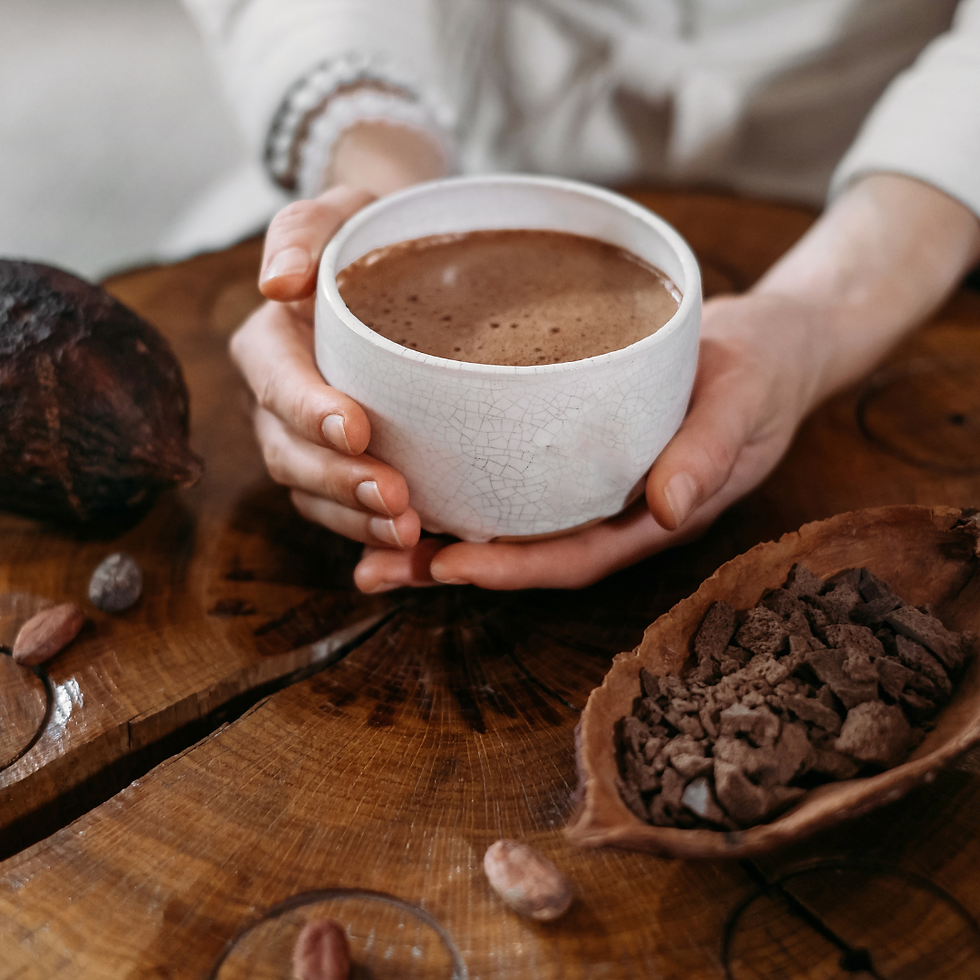What is a Cacao Ceremony?
- Becky Higgs

- May 22
- 3 min read
In recent years, the popularity of cacao ceremonies has been on the rise as individuals are drawn to the ancient ritual for its transformative and healing qualities. However, the origins of this practice and its historical background are often questioned. This article aims to uncover the deep-rooted history and beginnings of cacao ceremonies while examining their importance in today's culture.

The History of Cacao Ceremonies
For millennia, indigenous cultures in Central and South America have utilized cacao as both a medicinal remedy and a ceremonial plant. The ancient Maya and Aztec civilizations held cacao in high esteem as a sacred plant, incorporating it significantly in their religious rituals and everyday activities.
At these rituals, cacao was ingested in the form of a bitter drink produced from roasted cacao beans. It was commonly blended with spices and additional elements like honey or chili to enrich its taste and therapeutic qualities. The drink was thought to offer numerous health advantages, like boosting energy levels, aiding digestion, and enhancing cognitive function.
The Spiritual Significance of Cacao Ceremonies
In addition to its medicinal benefits, cacao was regarded as a potent means for spiritual communion and personal growth. The Maya viewed cacao as a divine offering, capable of forging a link between humanity and the sacred.
The spiritual importance remains evident in modern cacao ceremonies. Individuals come together in a circle to consume a specially crafted cacao elixir. It is common for them to establish intentions for the ceremony, as the cacao is thought to aid in unlocking the heart and fostering a more profound bond with oneself and those around them.

Before you go
To start off, make sure to arrive with an open mind and an empty stomach. Cacao is strong and flavourful, and it's most enjoyable when consumed on an empty stomach to prevent any potential discomfort. Additionally, wear comfortable attire as you may be reclining for a few hours.
During the Ceremony
Anticipate that the ceremony will commence by establishing an intention. This may range from gaining clarity on a personal matter to desiring to unwind and savour the moment. While the cacao is distributed, the leader will lead the participants in meditation or chanting, facilitating a profound connection with oneself and the spirit of cacao.
The Heart of the Matter
Cacao is recognised for its ability to open the heart. It enhances blood circulation and uplifts mood thanks to its natural components. On an emotional level, it has the potential to uncover repressed emotions. Participants often undergo a variety of emotions, spanning from peaceful joy to deep sorrow and everything in between.
After the Ceremony
After consuming cacao, you may experience a sense of euphoria and increased awareness. It is recommended to dedicate some time to journaling or reflecting on your experience while it is still vivid.

Integrating the Experience
After the ceremony, you may notice that insights or emotions keep surfacing. Allow yourself time to work through these feelings. Engaging in conversations with other participants or the facilitator can offer new viewpoints and enhance your comprehension.
Conclusion
The tradition of cacao ceremonies has a rich history and is becoming increasingly significant in today's society. Whether you seek healing, connection, or personal development, cacao ceremonies offer a unique and meaningful chance to explore your inner self and find peace and insight. If you are interested in experiencing this ancient practice, you might consider attending one of our cacao ceremonies in our clinic in Westcliff-on-Sea, Essex. Please join our Facebook group to see when the next event will take place.
.png)





Comments